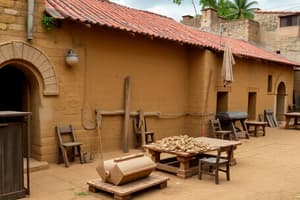Podcast
Questions and Answers
What is a key characteristic of primary sources regarding reliability?
What is a key characteristic of primary sources regarding reliability?
- The farther the date of creation, the more reliable it is.
- The closer the date of creation, the more reliable it is. (correct)
- Primary sources always require external criticism before evaluation.
- Primary sources are generally more subjective.
In evaluating the credibility of a source, which is NOT a question to ask regarding internal criticism?
In evaluating the credibility of a source, which is NOT a question to ask regarding internal criticism?
- What is the agenda behind its creation?
- What is the literal meaning?
- How many pages does the document contain? (correct)
- Was it written by an eyewitness or not?
Which factor is NOT associated with Howell and Prevenier’s evaluation of internal criticism?
Which factor is NOT associated with Howell and Prevenier’s evaluation of internal criticism?
- Competence of the observer
- Genealogy of the document
- Authorial authority of the document
- Historical context of the document (correct)
What specific claim was highlighted about Fr. Jose Ma. Pavon in William Henry Scott's findings?
What specific claim was highlighted about Fr. Jose Ma. Pavon in William Henry Scott's findings?
Which of the following best describes a secondary source?
Which of the following best describes a secondary source?
The process of verifying the authenticity of a historical document through its physical characteristics is known as what?
The process of verifying the authenticity of a historical document through its physical characteristics is known as what?
Which statement accurately captures an aspect of historical reliability?
Which statement accurately captures an aspect of historical reliability?
What misconception is addressed regarding Jose Rizal and 'Sa Aking Mga Kabata'?
What misconception is addressed regarding Jose Rizal and 'Sa Aking Mga Kabata'?
What is the primary purpose of history in uniting a nation?
What is the primary purpose of history in uniting a nation?
Which of these is a characteristic of primary sources?
Which of these is a characteristic of primary sources?
Which inquiry is NOT one of the six points to evaluate primary sources?
Which inquiry is NOT one of the six points to evaluate primary sources?
What distinguishes secondary sources from primary sources?
What distinguishes secondary sources from primary sources?
Which of the following sources is MOST likely a primary source?
Which of the following sources is MOST likely a primary source?
What does the term 'firsthand testimony' refer to?
What does the term 'firsthand testimony' refer to?
Which of the following best describes a secondary source?
Which of the following best describes a secondary source?
Which approach is NOT typically part of external criticism?
Which approach is NOT typically part of external criticism?
What is the traditional understanding of history?
What is the traditional understanding of history?
What is the modern concept of history derived from?
What is the modern concept of history derived from?
Which period is referred to as Pre-History?
Which period is referred to as Pre-History?
What is the primary role of historians?
What is the primary role of historians?
What does historiography refer to?
What does historiography refer to?
Which of the following best describes 'Pantayong Pananaw'?
Which of the following best describes 'Pantayong Pananaw'?
What is the first step in historical research?
What is the first step in historical research?
How are primary and secondary sources distinguished?
How are primary and secondary sources distinguished?
Flashcards are hidden until you start studying
Study Notes
Meaning and Relevance of History
- Traditional understanding defines history as the study of past events through significant chronological records and explanations of causes.
- Modern interpretation of history originates from the Greek word “Historia,” meaning knowledge gained through inquiry.
- Sources of history include oral traditions such as epics, songs, artifacts, and memories.
Divisions of History
- Pre-History: A period lacking written records analyzed by archaeologists and anthropologists through fossils and artifacts.
- History: Begins when writing systems are developed; studied through engraved metals, papyrus, and papers.
Role of Historians
- Historians select relevant sources and structure the past to demonstrate its continuing relevance.
- They emphasize the significance of historical understanding in shaping collective memory.
History as a Social Science
- History is categorized under social sciences alongside economics, political science, sociology, anthropology, philosophy, geography, and psychology.
Historiography
- Involves the writing of history through critical examination of sources, selecting details from authentic materials, and synthesizing narratives.
Importance of History
- Unites nations and legitimizes regimes, fostering collective identity through shared memories.
- Helps to comprehend the present, learn from past mistakes, and inspire future actions.
Historical Timeframe of the Philippines
- Covers significant eras from 9000/7000 BCE (Pre-historic) to the 21st Century, including Spanish, American, and Japanese eras.
Historical Sources
-
Primary Sources: Created during the same time as the events, including diaries, letters, interviews, and photographs.
- Inquiries involve date, localization, authorship, original integrity, analysis basis, and credibility.
-
Secondary Sources: Developed by authors who interpret primary sources, such as books and journals written years after events.
Evaluating Sources
- Primary sources are deemed more reliable closer to the event; secondary sources are more credible if recent.
- Validity and credibility of sources should be assessed through questions about the author’s presence at events, source origin, and dependency on multiple sources.
Historical Criticism
-
External Criticism: Verifies authenticity by examining physical traits, historical consistency, authorship, and material usage.
- Inquiries include when, where, and by whom the source was produced.
-
Internal Criticism: Investigates truthfulness and context, considering author credibility and the agenda behind the creation.
- Questions involve the eyewitness status of the author, reasons for writing, and content consistency.
Noted Historical Forgery
- Jose Rizal is not the author of "Sa Aking Mga Kabata"; allegations of forgery include figures like Jose Marco and Roman Roque.
- William Henry Scott determined inconsistencies in authorship related to Fr. Jose Ma. Pavon’s timeline and the Spanish monarchy.
Studying That Suits You
Use AI to generate personalized quizzes and flashcards to suit your learning preferences.




